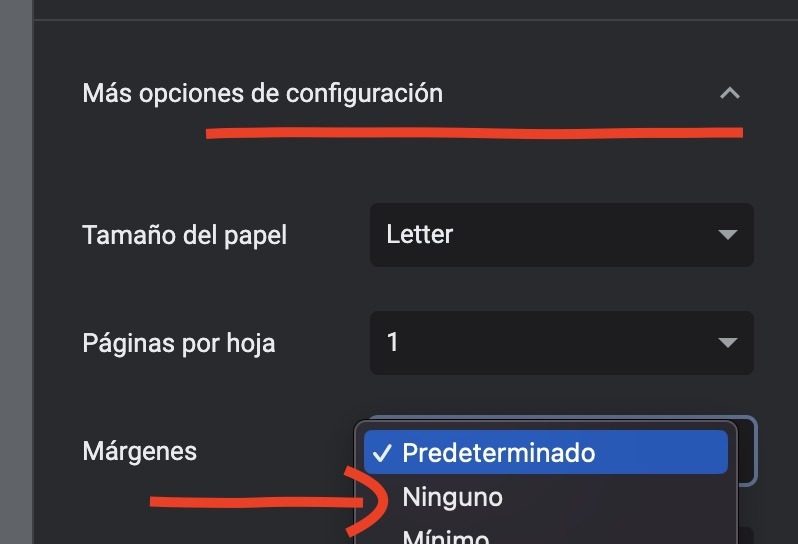English 4 Unit 2 Term 1 Week 1, 2025
Instrucciones:
• Los bloques sombreados en color gris se pueden ocultar en la impresión final.
• Para ello haga clic sobre cada uno de los bloques que desea ocultar.
• Para encenderlo nuevamente, pulse el bloque otra vez.
• Solamente los bloques encendidos serán impresos.
• Pulse el botón «Imprimir» cuando se encuentre listo.
• Para un mayor aprovechamiento del espacio, recomendamos eliminar los márgenes al imprimir.
¿Cómo guardar PDF?

Recomendamos utilizar el navegador Google Chrome.
Si no lo tiene instalado en su dispositivo puede descargarlo aquí.
El diálogo de impresión iniciará en cuanto cierre estas instrucciones.
En el cuadro de diálogo, cambie el destino de la impresión:

En las opciones, seleccione «Guardar como PDF»:

Para aprovechar todo el espacio de su hoja, recomendamos desactivar los márgenes:

Por último pulse el botón «Guardar»:

¿Cómo imprimir en color?

Recomendamos utilizar el navegador Google Chrome.
Si no lo tiene instalado en su dispositivo puede descargarlo aquí.
El diálogo de impresión iniciará en cuanto cierre estas instrucciones.
En el cuadro de diálogo de la impresión siga las siguientes instrucciones:
Si desea imprimir el planeamiento a color, asegúrese de activar la opción «Color»:

En la sección «Más configuraciones»:

Active la opción «Gráficos de fondo»:

Finalmente pulse el botón «Imprimir»:

School year: 2025
Period:
Term: I
Level: Forth Grade
Unit: 2
Week: 1
Domain: Socio-interpersonal
Scenario: Natural Treasures
Theme: Places and People at the Park
Enduring Understanding: National parks provide homes and food to animals and jobs, education and entertainment for people.
Essential Question: Why do national parks matter to us?
General Competences:
Responsible Citizenship ( X )
Life Competences ( )
Competences for Employability ( )
Learn to Know
Grammar & Sentence Frames
Simple present using (S-V-C) pattern
- The beach is beautiful.
- The mountain is steep.
- The Forest is…
There is/are with conjunctions and/or.
- In Manuel Antonio, there are monkeys, sloths and birds.
- There are mountains and streams.
- Santa Rosa National Park you can visit the historical museum or the walk on the trails
Phonemic Awareness
Short vowels:
/ æ /sad, fat, am,
/e /dress, vest, ,red
Vocabulary
1.Places and people at the park
National park
- Landmarks
- Wildlife, forest
- Warning signs
- Restrooms
- Picnic areas
Descriptive adjectives
- Clean
- Peaceful people at the park
- park ranger
- tour guide
Learn to Do
Function
Describing people, places, and things
Discourse Markers
Linkers: Sequential – past tense
First, then, after- that, finally
Learn to Be and Live in Community
Psycho-social
Taking personal and social responsibility to care for nature.
Sociocultural
Using the right choice of greetings & address forms (e.g. “High fives” and “fist bumps”)
Idioms/phrases
Proverbs/idioms:
“A breath of fresh air…” (something new or different makes the experience more exciting)
Assessment Strategies & Evidences of learning
Learner…
L.1. Recognizes short and clear explanations when delivered slowly.
Indicator of learning:
Recognizes short and clear explanations about Costa Rica National Parks, when delivered slowly.
Goals
Learner can…
L.1. understand short and clear explanations when delivered slowly (e. g The description of a national park).
Pedagogical Mediation/ Didactic Sequence
Pre- teaching
Essential Question: Why do National Parks matter to us?
Warm Up
Students look at page 36 in the book.
Teacher asks the students:
Where can you see these kinds of animals?
Activation of Prior Knowledge
Teacher asks:
- What can you find in a National Park?
Students brainstorm and the teacher writes some of them on the board.
(Some answers may change a little)
Modeling
Teacher explains the function of the modal “should”.
Should + verb to give advice or suggest something.
Observe page 54 and listen to the teacher`s explanation.
Students complete page 54.
Clarifying
The teacher gives extra examples or explanation if needed.
Time
R.1. Recognizes much of what is written in short, simple texts on subjects with which they are familiar and/or in which they are interested.
Indicators of learning:
Recognizes much of what is written in short, simple texts about national parks.
SP.1. Expresses common feelings during an oral presentation.
Indicator of learning:
Expresses how national parks make them feel, during an oral presentation
R.1. understand much of what is written in short, simple texts on subjects with which they are familiar and/or in which they are interested.
Express common feelings during an oral presentation.
Pre-task
The teacher writes on the board a suggestion that could be found in a National Park.
Example:
- You shouldn’t pick flowers
Students brainstorm 2 more ideas of advices or suggestions for a National Park.
Students read and complete page 55 in the book.
Task – Rehearsal
Students work in pairs or in groups of three and design in the notebook a sign to be placed in a National Park, different than the ones illustrated on page 55.
Students must use should or shouldn`t and must illustrate it.
The teacher checks the sign for grammar and spelling.
Task completion
Students work in pairs or groups of three to build a sign in a piece of paper, construction paper or cardboard (cartulina) with markers and color pencils.
Task – Assessment
Students` groups share their signs with their class.
They must explain why that sign is important to follow in a National Park.
The idea is for students to take personal and social responsibility to care for nature.
Post task
Students could paste the signs around the class or the school.